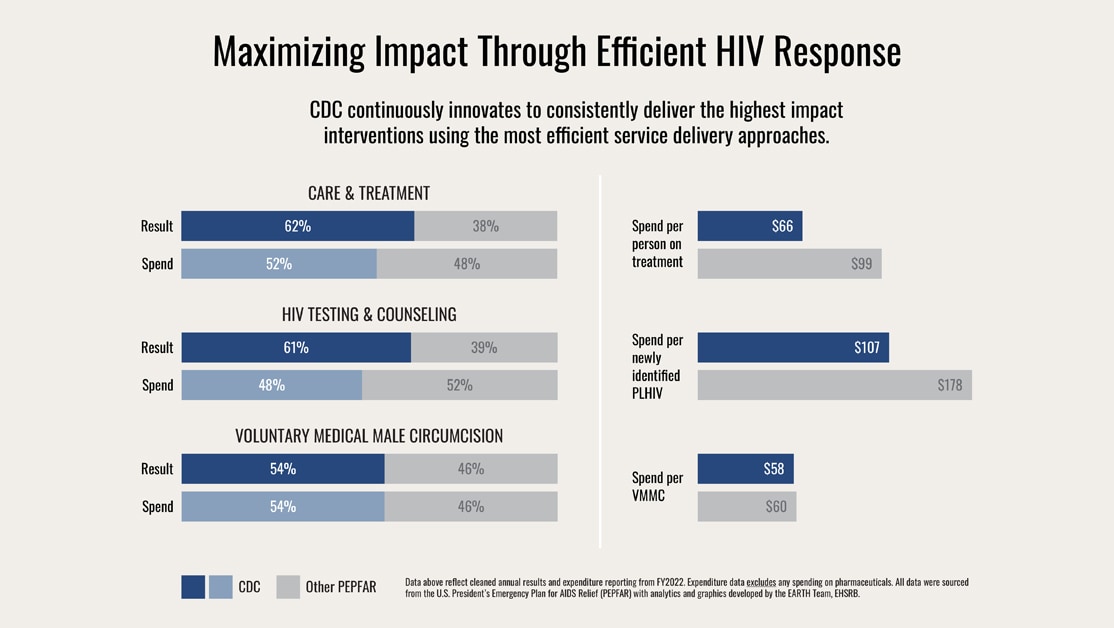At a glance
CDC plays a vital role in PEPFAR working to end HIV and TB in more than 50 countries. CDC's commitment to local partnerships is key to successful implementation of interventions based on local needs and context. CDC's PEPFAR implementation is effective and efficient, saving millions of lives each year.
CDC's efficient implementation of PEPFAR

For more than 40 years, CDC has been a global leader in the fight against HIV and tuberculosis (TB). CDC plays a vital role in PEPFAR, working to end HIV and TB in more than 50 countries.
CDC's implementation of PEPFAR is very effective, saving millions of lives each year and making the most of every dollar spent. CDC receives around half of PEPFAR funding for HIV treatment globally. With this funding, CDC and partners support over 60 percent of people on PEPFAR-supported antiretroviral treatment.
Making Every Dollar Count.
Commitment to local partnerships
CDC is committed to supporting local partners. By supporting local leadership of the HIV response, CDC supports sustainability for collective impact into the future. In 2021, more than 70 percent of CDC direct funds went to local and indigenous partners with proven credibility and expertise. This is compared to 40-50 percent spent by other PEPFAR agencies in the same year. This approach strengthens local expertise and provides a cost-effective model for lasting change.

Interventions based on local evidence
As a scientific agency, CDC bases its PEPFAR work on evidence, constantly monitoring and evaluating our programs. CDC innovates to provide the most impactful interventions using efficient methods. CDC also tailor interventions to the specific needs of local communities, avoiding one-size-fits-all approaches that may be less effective and cost more.
In Nigeria, CDC used the 2018 Nigeria AIDS Indicator and Impact Survey to find previously unidentified people living with HIV (PLHIV). They reached out to these communities with innovative HIV testing services and interventions. These efforts occurred in the community and at healthcare facilities during the "HIV treatment surge" from 2019 to 2022. Local CDC implementing partners forged partnerships with indigenous community-based organizations in underserved areas, expanding programs that included testing and treatment initiation. These efforts were implemented through community treatment models and by facilitating individuals' connection to healthcare facilities.
This collaborative effort notably reduced the treatment gap in all 19 CDC-supported states. CDC experts collaborated with local implementing partners to improve data quality and its utilization at the site level for program improvement. Nigeria employed its inventive Retention Revolution, which included a satisfaction survey to pinpoint causes of treatment interruptions and inform targeted interventions.
This led to a decrease in treatment interruptions to below two percent in the supported states. It also led to a remarkable increase in viral suppression from 84 percent pre-surge to 96 percent currently among PLHIV. Thanks to these locally data-driven approaches, Nigeria is making significant progress toward reaching its goals for ending its HIV epidemic.
Partner support and engagement
CDC collaborates with National Public Health Institutes in countries, drawing on our collective experience on HIV and TB treatment and prevention. CDC's unique role derives from over 40 years of collective HIV experience, and over 60 years of collective TB experience.
In Botswana, CDC recently initiated a mentorship program that includes clinical, laboratory, and strategic information mentorship. This approach enhances efficiency and sustainability by transitioning PEPFAR support from direct service delivery to providing technical assistance. It also empowers the government with the necessary structures and expertise to deliver high-quality, standardized HIV services nationwide.
The creation of this framework within the Ministry of Health provides a model for ongoing PEPFAR support in the future. The Government of Botswana is committed to expanding its financial support for its HIV programs. PEPFAR will continue offering technical assistance to maintain quality and build upon the progress achieved over the years with PEPFAR-support.
The United States, through PEPFAR's five-year strategy, aims to eliminate HIV as a global public health threat by 2030. CDC is committed to using its cutting-edge approaches and scientific expertise to contribute to ending the world's two deadliest infectious diseases. This involves maintaining PEPFAR's significant progress and finding more efficient ways to reach everyone in need of HIV treatment and prevention.
